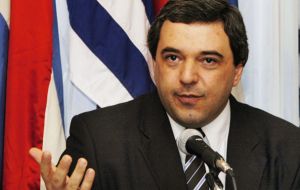MercoPress. South Atlantic News Agency
Uruguay raises basic rate; gives priority to inflation target
 Exporters are complaining but central banker Mario Bergara anticipates no major risks with a stronger peso
Exporters are complaining but central banker Mario Bergara anticipates no major risks with a stronger peso Uruguay’s central bank raised on Friday its overnight lending rate to 6.5% from 6.25% as inflation expectations are above the target range of 4% to 6%. The decision took the market by surprise since exporters have been asking for a stronger US dollar, but the Economy ministry said “it did not visualize a loss of competitiveness”.
The bank’s five-member policy committee, led by bank President Mario Bergara decided to raise the rate after keeping it unchanged in the previous two meetings. In December, the bank cut it from 8% to 6.25%.
The committee “continues to see a context of high rates of growth and historically low level of unemployment,” the bank said on its website.
The bank took into account inflationary pressures created by overseas demand for goods coupled with the effect of strong domestic demand that is outstripping local supply, according to the statement. The Uruguayan economy grew 10.4% in the second quarter from a year earlier, the fastest pace in at least six years.
Annual inflation slowed in August to 6.25% from 6.29% in July. Bergara said in a July 27 interview that the bank is “comfortable” with the rate of inflation and sees no reason for concern about a sharp increase in prices.
Pervious to the Central bank decision there was a meeting of the Macroeconomic Coordination Committee (Central bank plus the Ministry of Economy) which approved the move. The Economy ministry argued combating inflation was a priority and downplayed the risks of loss of competitiveness because of the US dollar depreciation in the Uruguayan market, (as in most of the rest of South America).
However the Committee reiterated its commitment with the several objectives of the current economic policy and ratified the ‘coordinated strategy” including participating in the foreign exchange market, inline with basic macroeconomic equilibrium”
Uruguay’s peso has gained 6.1% against the dollar in the past 12 months, the second-biggest gain after Chile’s peso among eight major Latin American currencies. The stronger peso has led producers and exporters to complain about their loss of competitiveness overseas, said Javier de Haedo, a former Uruguayan under secretary of economy.
“The bank and the Economy Ministry are seeking a balance between the inflation target and a competitive exchange rate,” de Haedo said.
Only last June Deputy Economy minister Pedro Buonomo described the Committee’s “point of equilibrium” at 21 to 22 pesos to the US dollar. However on Friday the exchange rate was back to the level before June, just over 20 Pesos.




Top Comments
Disclaimer & comment rulesCommenting for this story is now closed.
If you have a Facebook account, become a fan and comment on our Facebook Page!